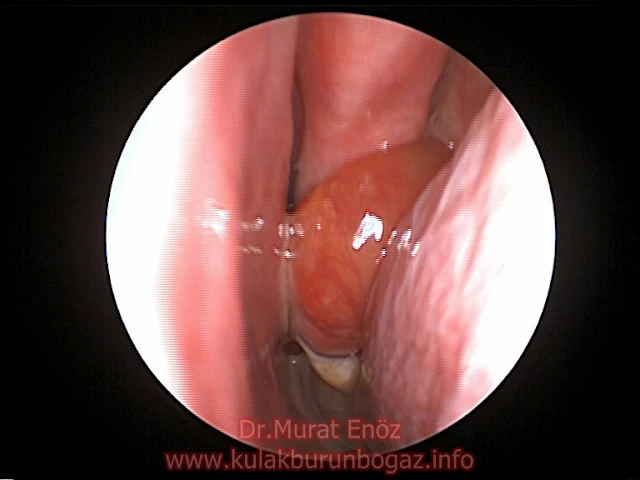The antrochoanal polyp (ACP)
Definition nasal polyposis is a disease of the nasal and sinus mucous membranes, especially the ethmoid labyrinth, with an unknown cause of chronic inflammation and multifocal edematous transformation of the mucosa. It usually occurs when the ethmoid sinus mucosa prolapses. Simple polyps can occur at any time after the age of 2. However, it is not very common for simple polyps to be seen before the age of 10. Polyp is an ancient Greek word that means multi-legged.
Antrochoanal polyp is a type of nasal polyp that originates from the maxillary sinus on both sides of the nasal entrance and can extend to the back of the nasal cavity and nasal area. Sometimes they can reach large sizes and when viewed from inside the mouth, they may look like a bubble full of liquid, extending from top to bottom. It can move with head movements, and recurrent sinusitis attacks, runny nose, decrease in smell (anosmia) can be added to the picture by disrupting the sinus ventilation. Antrochoanal polyps are usually seen in children and are unilateral.
Antrochoanal polyp arises from the maxillary sinus and extends from the sinus ostium to the choana. It is mostly seen unilateral in childhood. It is known that up to 70% of antrochoanal polyp arises from the accessory ostium. These patients often cause unilateral nasal obstruction and nasal discharge. Although antrochoanal polyps have been associated with allergic rhinitis, chronic inflammatory process in a limited number of studies, the real cause is still unknown.
Antrochoanal polyps are usually seen unilaterally during careful endoscopic examination. In patients with turbinate hypertrophy and nasal septum deviation, they may accidentally be overlooked on the obstructed side of the passage.
Treatment consists of removing this polyp by endoscopic sinus surgery. The sinus ostium where the polyp originates is usually already enlarged by the polyp. Endoscopically, the aspiration of the sinus content from which the polyp originates is performed at the same time in order to reduce the risk of polyp development again.
In a study of 200 cases by Frosini et al. (Antrochoanal polyp: analysis of 200 cases), It was found to be statistically associated with septum deviation (55%) and inferior concha hypertrophy (42%). Edema that develops due to allergy or infection at the osteo-meatal complex or middle meatus level disrupts the aeration of the sinus. Intramural cyst may herniate towards the outside due to increased pressure in the sinus. The closure of the sinus ostium causes the polyp to protrude from the accessory ostium. Therefore, according to the venturi-bernolli principle, reasons such as concha bullosa, septal deviation and inferior turbinate hypertrophy may cause antrochoanal polyp. For this reason, opening a large maxillary ostium in antrochoanal polyp surgery results in less recurrence rates.
How can you tell if you have a polyp in your nose?
Some patients with nasal polyps may have a history of allergic-based diseases such as allergic rhinitis or asthma, and some patients may state that they have polyps in their families. However, not all patients with nasal polyps have allergies. If you have a polyp in your nose, the following complaints may usually occur:
- A decrease in the sense of smell taken from the nose. This may be due to the narrowing of the air space in the nose of the polyp as well as the chronic inflammation of the olfactory region and its covering with polypoid tissues.
- Increasing nasal congestion. It is usually accompanied by a decrease in the sense of smell.
- Feeling that something is moving in the nose with head turning, especially in patients with antrochoanal polyps, this may occur, but it is not necessary for every patient. In some patients, polypoid tissue can be seen protruding from the nasal cavity into the oral cavity.
The link you can find details about nasal polyps >> Nasal Polyp - Definition, Symptoms, Diagnosis and Treatment
Source links >>
Murat Enoz, MD, Otorhinolaryngology, Head and Neck Surgeon - ENT Doctor in Istanbul
Private Office:
Address: İncirli Cad. No:41, Kat:4 (Dilek Patisserie Building), Postal code: 34147, Bakırköy - İstanbul
Appointment Phone: +90 212 561 00 52
Appointment Phone: +90 212 561 00 52
Fax: +90 212 542 74 47



Comments
Post a Comment